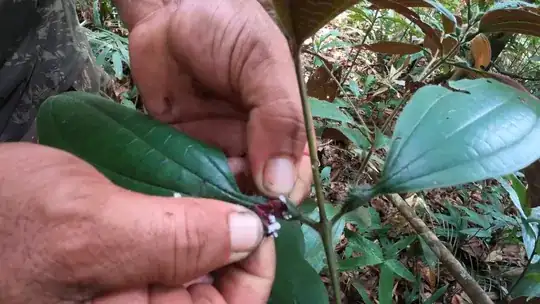1 Answers
Using Neotropical myrmecophilous Melastomataceae – an annotated list and key (F. Michelangei 2010), I got as far as, "Subkey 4: Domatia as paired ascidia at the apex of the petiole or the base of the leaf blade." The video doesn't show enough details to work through the next steps in the key. So that leaves us with a list of about 68 possible species, in 8 genera (Blakea, Tococa, Allomaieta, Maieta, Clidemia, Ossaea, Henriettea, and Conostegia).
Based on the genus descriptions, we can rule out Allomaieta and Maieta because your specimen does not have its domatia immersed in the leaf blade. We can rule out Conostegia because it houses ant in the stems or in domatia in the leaf blade, while your species houses ants in domatia on the petiole
That leaves 5 possible genera, Blakea, Tococa, Clidemia, Ossaea and Henriettea. All are in Subfamily Melastomatoideae, and they're all pretty similar looking. You may be able to narrow it down to a short list of species if you spend time reading through the individual species descriptions and ruling out the ones where you have enough information. Many of them use floral characteristics, which unfortunately are not visible in the video. They also use "anisophyllous" as an important characteristic, which means having two different types of leaf. The video does show a pair of leaves that don't have domatia, but I'm not sure if those are truly a different leaf form, or if those two leaves are just immature and haven't yet developed their domatia. You may also be able to narrow it down based on the degree of hairiness, but you would probably need to compare plant images because relative hairiness is very different to describe (despite a wide botanical vocabulary intended to do exactly that, from hirsute to glabrous with many gradations in between).
You may find Flora do Brazil, the official list of all plant species in Brasil, a useful resource. iNaturalist is a great place to get plant photos for a given species (for more obscure plant species I don't trust Google image search to return accurately identified photos).
On the other hand, if you decided give up on decisively identifying it and just call it a Clidemia, very few people will argue with you.
- 2,280
- 4
- 12
